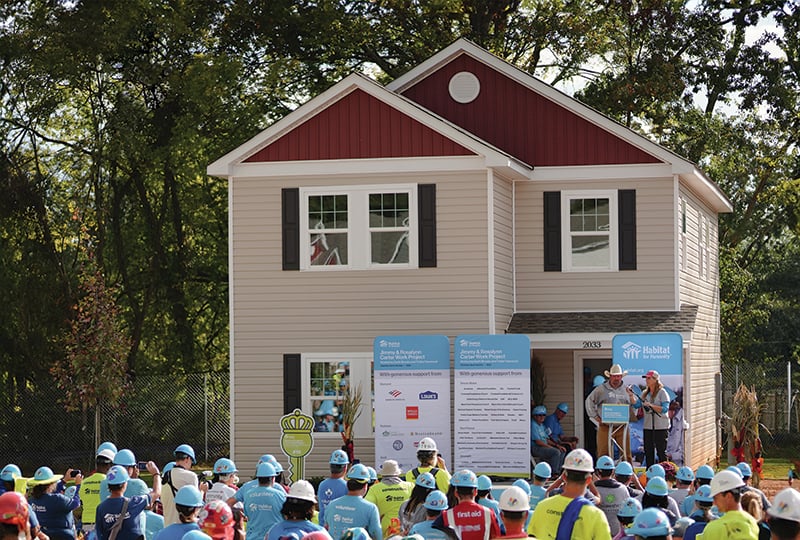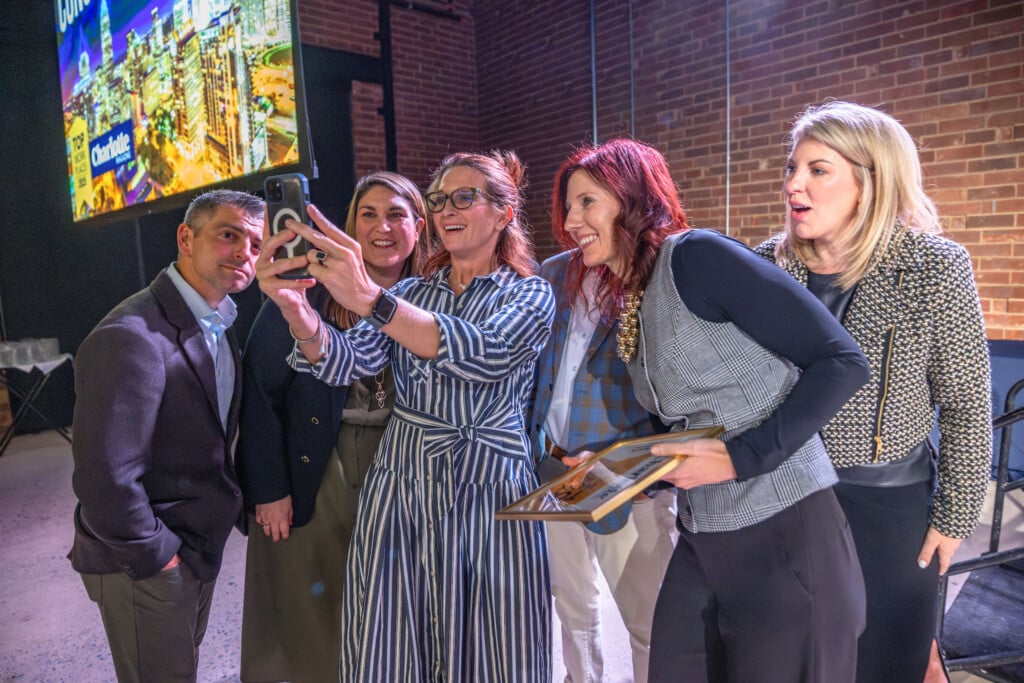Two Nonprofits, Two Country Music Stars, and Hundreds of Volunteers Do Miracle Work
Building human-scale solutions in the face of systemic crises

In the first week of October, hundreds of volunteers from around the world gathered in west Charlotte to build 27 affordable homes. Construction began early on a clear, warm morning. By afternoon on the first day, the frames were already taking shape, and the main work site rang with the percussion of hammers and whine of circular saws.
It was the latest installment of Habitat for Humanity’s Carter Work Project, an annual construction bonanza named for Jimmy and Rosalynn Carter, who hosted and volunteered at the event from its inception in 1984 until 2019. This year, country music stars Garth Brooks and Trisha Yearwood picked up their mantle after a three-year COVID hiatus, and both were on-site for the project—a day after the former president’s 99th birthday. At one home, Yearwood hammered away at a roof trellis as Brooks scaled a ladder, level in hand, to secure a rafter.
About 4 miles east, in uptown’s Third Ward, another construction project is underway. Next year, the Charlotte Rescue Mission will open a 72,000-square-foot facility to house its Rebound program, which helps homeless individuals overcome addiction.
When the Rev. Tony Marciano joined the Mission as CEO in 1996, leadership had been discussing a new facility for years. In the decades since, homelessness—and the Mission’s need for a bigger space—has grown with the city. The five-story building will include a commercial kitchen, cafeteria, chapel, classroom, medicine room, and fitness center. The gleaming, expansive space is a bittersweet accomplishment. It’s nice that we have it; it’s a tragedy that we need it.
Both Habitat for Humanity and Charlotte Rescue Mission are up against crises that stem from societal failures: the lack of affordable housing and the dual scourge of homelessness and addiction. They alone can’t fix the systemic rot, but both organizations build strong foundations for some of the individuals affected. Against such overwhelming forces, their efforts take on a divine tint: The Mission’s capital campaign for the new Rebound facility was called “Miracle on Cedar Street.” The last time Charlotte hosted the Carter Work Project, in 1987, the homes they built in Optimist Park were known as “the Miracle on 18th Street.”
Marciano speaks in a register and cadence that suggest he often repeats the same stories and statistics. I can forgive him for sermonizing. He’s a preacher, and for decades, he’s tried to solve a problem that few understand or care about.
He describes a common scenario: “You’re driving to work, and you see somebody holding a sign that says, ‘Hungry, will work for food,’ you roll down your window, you give them $5 or $10, you say, ‘God bless you,’ then you roll up your window and drive to work.” He pauses, then poses a question he’s asked many times before: “What do you want to see happen in that person’s life?”
Nobody has an answer, he says. They just drive off. “This is the question that Charlotte has to answer,” he says, “and doesn’t want to answer.”
In 2007, the City Council adopted a 10-year plan to end and prevent homelessness. Since then, the number of Charlotteans experiencing homelessness has grown. As of May 31, 3,162 people in Mecklenburg County lacked housing. Of those, 164 were unaccompanied youth. This year, a study by Home Bay, a California-based real estate brokerage firm, found that Charlotte has one of the smallest homeless populations among major cities. But homelessness has steadily grown here in recent years and will likely worsen as rents rise.
Charlotte Rescue Mission serves an acute need. Estimates vary, but at least a third of homeless people struggle with substance abuse. Among homeless veterans, that figure is much higher. In a United States Conference of Mayors survey, 68% of cities reported that substance abuse was the largest cause of homelessness among single adults.
In June, the United Way of Greater Charlotte released an implementation plan for a countywide initiative called “A Home for All,” which aims to make homelessness “rare, brief, and nonrecurring.” A key element of the vision is, as the name suggests, that “every person has access to permanent, affordable housing and the resources to sustain it.”
Charlotte, following Houston’s example, has adopted a “housing-first” approach to homelessness, and the plan includes rental assistance, eviction protection, and home-repair funds. “Housing first” refers to an approach psychologist Sam Tsembiris developed in New York in the 1990s, premised on the conviction that stable housing could precede addiction treatment. Studies show that the method works, and “housing first” became federal policy in 2009.

The Rev. Tony Marciano, Charlotte Rescue Mission’s CEO, outside the charity’s new center in Third Ward.
But Marciano is adamant that housing is not a panacea. “It’s way too easy,” he says, “to simply say that if we house our homeless neighbors and they get a job—but they live in squalor housing and they have a job that’s very difficult for them, but they’re alive—then we’ve done our work for them, and that’s a good thing.”
Thirty-eight percent of the men the Mission serves, and 95% of the women, have been sexually abused. All of them grapple with drug and alcohol addiction. Marciano describes how this coalesces into a “shame-based identity,” often accompanied by complex PTSD, which impairs the ability to learn and make decisions and traps the brain in flight, fight, or freeze mode. Sticking these people in apartments, Marciano says, isn’t going to cut it.
The Mission, a Christian organization, takes a more comprehensive approach and, in addition to shelter, offers counseling, group therapy, work sessions, Alcoholics Anonymous, and a life skills program. In the new building, the 120-day program will be able to serve 25 more men per quarter—100 per year. (The women’s program will be in a different facility.)
Of all the new building’s features, Marciano is most excited about the admissions space, a private area where incoming residents are protected from the hubbub and scrutiny of the lobby. “There, you’ll relax in privacy and dignity and perhaps experience dignity and respect for the first time in your life,” he says. “I’m hoping that those few brief moments, where you go, ‘I’m safe,’ changes the whole trajectory of your life.”
For others, affordability is the primary barrier to stable housing. Workers who earn minimum wage, $7.25 per hour, must work 108 hours per week—more than two full-time jobs—to afford an average one-bedroom apartment, county data show. Since 1983, Habitat for Humanity of the Charlotte Region has helped more than 3,500 families secure affordable housing, both by building and preserving homes.
But, says CEO Laura Belcher, “it’s not enough to quietly be out building homes. We need to be out loudly building homes and drawing attention to the inequity that exists in our community. … If we are a community that cares about economic mobility and racial equity, we have got to provide more affordable housing.”
Belcher paints a bleak picture of how that’s going: The gulf between incomes and housing costs is widening. Out-of-town investors are snapping up inventory. In a tight housing market, wealthy shoppers have the option to buy down—to buy less expensive homes they can easily afford—which robs their lower-income peers of the opportunity to enter the market at all. And when it comes to racial homeownership gaps, Belcher says, “we are no better today than we were 50 years ago.”
Belcher has been CEO for nine years. Contrary to her expectations, “it actually feels like the longer I’m working in housing, the harder it’s getting,” she says. “Market forces are working against us. I joke that our team has to get up every day and put on battle armor because we’ve gotta go fight market forces.”
From that perspective, their efforts verge on quixotic. But some families realize a benefit that transforms their lives. The 27 homes that volunteers, staff, and homeowners built in October are part of The Meadows at Plato Price, a 39-home development and the local Habitat’s biggest project to date.
Katie Ousseini, 51, helped finish construction of her home at The Meadows during the Carter Work Project. She’s grateful that she and her three children can live in an area they know, close to her work in administration at Eastover Elementary. Ousseini, who has worked for Charlotte-Mecklenburg Schools for 25 years, has colleagues who’ve moved to China Grove and Salisbury to buy homes. She wouldn’t have been able to do it here without Habitat’s help.

Katie Ousseini paints trim in her new Habitat home. She’s worked in Charlotte-Mecklenburg Schools for 25 years but says she wouldn’t be able to buy a home here without Habitat’s help.
“We have what are considered good jobs—we’re state employees who can’t afford to live in Charlotte,” she says. “We’re not considered poor. We’re just average.”
Allison Braden is a contributing editor.





